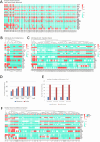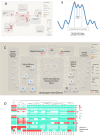Deciphering the topological landscape of glioma using a network theory framework
- PMID: 39496747
- PMCID: PMC11535471
- DOI: 10.1038/s41598-024-77856-y
Deciphering the topological landscape of glioma using a network theory framework
Abstract
Glioma stem cells have been recognized as key players in glioma recurrence and therapeutic resistance, presenting a promising target for novel treatments. However, the limited understanding of the role glioma stem cells play in the glioma hierarchy has drawn controversy and hindered research translation into therapies. Despite significant advances in our understanding of gene regulatory networks, the dynamics of these networks and their implications for glioma remain elusive. This study employs a systemic theoretical perspective to integrate experimental knowledge into a core endogenous network model for glioma, thereby elucidating its energy landscape through network dynamics computation. The model identifies two stable states corresponding to astrocytic-like and oligodendrocytic-like tumor cells, connected by a transition state with the feature of high stemness, which serves as one of the energy barriers between astrocytic-like and oligodendrocytic-like states, indicating the instability of glioma stem cells in vivo. We also obtained various stable states further supporting glioma's multicellular origins and uncovered a group of transition states that could potentially induce tumor heterogeneity and therapeutic resistance. This research proposes that the transition states linking both glioma stable states are central to glioma heterogeneity and therapy resistance. Our approach may contribute to the advancement of glioma therapy by offering a novel perspective on the complex landscape of glioma biology.
Keywords: Endogenous network theory; Energy landscape; Gene regulatory network; Glioma; Glioma stem cell; Network dynamics.
© 2024. The Author(s).
Conflict of interest statement
The authors declare no competing interests.
Figures







Similar articles
-
Identification of Glioma Cancer Stem Cell Characteristics Based on Weighted Gene Prognosis Module Co-Expression Network Analysis of Transcriptome Data Stemness Indices.J Mol Neurosci. 2020 Oct;70(10):1512-1520. doi: 10.1007/s12031-020-01590-z. Epub 2020 May 26. J Mol Neurosci. 2020. PMID: 32451841
-
SWIM tool application to expression data of glioblastoma stem-like cell lines, corresponding primary tumors and conventional glioma cell lines.BMC Bioinformatics. 2018 Nov 30;19(Suppl 15):436. doi: 10.1186/s12859-018-2421-x. BMC Bioinformatics. 2018. PMID: 30497369 Free PMC article.
-
Quiescent stem cell marker genes in glioma gene networks are sufficient to distinguish between normal and glioblastoma (GBM) samples.Sci Rep. 2020 Jul 2;10(1):10937. doi: 10.1038/s41598-020-67753-5. Sci Rep. 2020. PMID: 32616845 Free PMC article.
-
Brain tumor stem cells as therapeutic targets in models of glioma.Yonsei Med J. 2010 Sep;51(5):633-40. doi: 10.3349/ymj.2010.51.5.633. Yonsei Med J. 2010. PMID: 20635435 Free PMC article. Review.
-
The Glioma Stem Cell Model in the Era of Single-Cell Genomics.Cancer Cell. 2020 May 11;37(5):630-636. doi: 10.1016/j.ccell.2020.04.001. Cancer Cell. 2020. PMID: 32396858 Review.
Cited by
-
Exploring Multi-Target Therapeutic Strategies for Glioblastoma via Endogenous Network Modeling.Int J Mol Sci. 2025 Apr 1;26(7):3283. doi: 10.3390/ijms26073283. Int J Mol Sci. 2025. PMID: 40244148 Free PMC article.
References
-
- Ignatova, T. N. et al. Human cortical glial tumors contain neural stem-like cells expressing astroglial and neuronal markers in vitro. Glia39, 193–206 (2002). - PubMed
-
- Galli, R. et al. Isolation and characterization of tumorigenic, stem-like neural precursors from human glioblastoma. Cancer Res.64, 7011–7021 (2004). - PubMed
MeSH terms
Grants and funding
LinkOut - more resources
Full Text Sources
Medical

